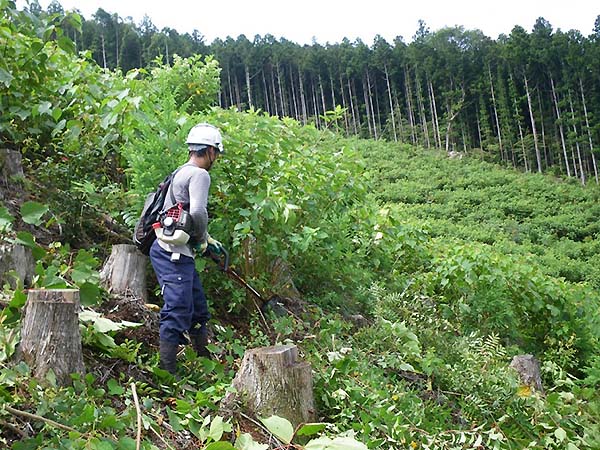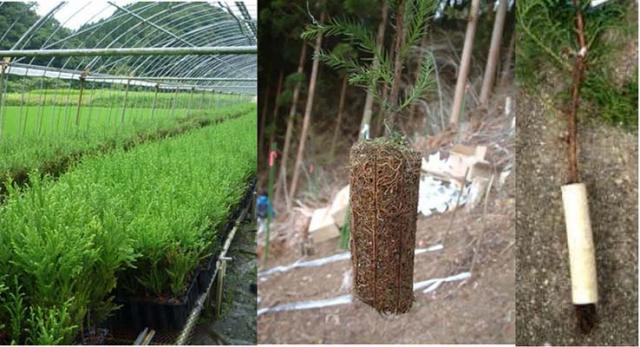Home > Research > Research Results > Research Results 2019 > Cut and plant: A broad-based survey reveals what type of sapling is suitable for reforestration
Update:October 11, 2019
Main content starts here.
Cut and plant: A broad-based survey reveals what type of sapling is suitable for reforestration
| Article title |
Survival rates and initial growth of Japanese cedar and hinoki cypress saplings in experimental plots aimed at low-cost silviculture |
|---|---|
| Author (affiliation) |
Atsushi Sakai (a), Fumiaki Kitahara (b), Keisuke Yamanaka (c), Takashi Mishima (d), Wakana Iwata (e), Hiromasa Shimada (f), Kiyotaka Okuda (g), Tomitaro Nakashima (h), Yumiko Yamashita (i), Sakae Fujii (j), Naoshi Watanabe (k), Koji Takano (l) (a) Tohoku Research Center, FFPRI, Morioka, Iwate, Japan. (b) Department of Forest Management, FFPRI, Tsukuba, Ibaraki, Japan. (c) Shimane Prefectural Mountainous Region Research Center, Iinancho, Shimane, Japan. (d) Shimane Prefecture East Region Agriculture and Forestry Promotion Center, Unnan, Shimane, Japan. (e) Shimane Prefectural Green Development Center, Matsue, Shimane, Japan. (f) Mie Prefecture Forestry Research Institute, Tsu, Mie, Japan. (g) Former Mie Prefecture Forestry Research Institute. (h) Kinki-Chugoku Regional Forest Office, Kameyama, Mie, Japan. (i) Wakayama Forestry Research Institute, Kamitondacho, Wakayama, Japan. (j) Tokushima Agriculture, Forestry and Fisheries Technology Support Center, Ishiicho, Tokushima, Japan. (k) Kochi Prefectural Forest Technology Center, Kami, Kochi, Japan. (l) Shikoku Regional Forest Office, Kochi, Japan. |
| Publication Journal |
Journal of the Japanese Forest Society, 101(2):94-98, April 2019 DOI:10.4005/jjfs.101.94( External link ) |
| Content introduction |
To sustain forestry, it is necessary to plant saplings after logging forests. However, reforestation costs a lot of money for purchasing and planting saplings and weeding them over several years after planting (Figure 1). To address the issue, it has been considered that saplings, such as multi-cavity container sapling (Figure 2 middle) and ceramic-pipe sapling (grown in a long cylindrical ceramic pipe filled with soil; Figure 2 right), are used to reduce the cost of reforestation, considering that simultaneous operations of harvesting and planting are employed. This study was conducted at 13 locations in Kinki, Chugoku, and Shikoku regions in Japan. To identify sapling suitable for planting, we investigated the survival rate and growth rate of various types of samplings (Japanese cedar and Hinoki cypress saplings) planted in the regions.Our results revealed that both survival and growth rates of multi-cavity container sapling were similar to those of bare-rooted sapling, which has been extensively planted till date. However, both survival and growth rates of ceramic-pipe sapling were lower than those of bare-rooted sapling.Furthermore, initial growth rate of the large bare-rooted sapling of Japanese cedar (taller than 60 cm) at the time of planting was fast. However, large saplings are heavy and time-consuming to transport and plant. Therefore, it is necessary to carefully consider places where these saplings can be planted, such as near a street. In this study, we conducted surveys beyond the borders of the prefectures and regions.Therefore, it was possible to understand the growth characteristics of saplings by conducting cross-cutting analysis. In the future, we would like to conduct similar research in collaboration with other regions.
Figure 1. Weeding work Working on slopes underneath blazing sun is labor intensive. Therefore, labor saving is necessary.
Figure 2. Multi-cavity container sapling lined on the shelf (left), its root condition (middle), and ceramic-pipe sapling (right) |
Copyright © Forest Research and Management Organization. All rights reserved.


